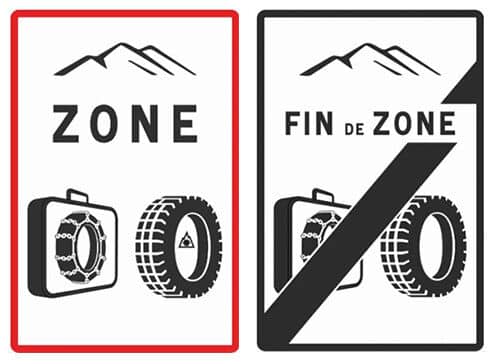From 1 November each year, vehicles travelling in Haute-Savoie from 1 November to 31 March must be fitted with four winter tyres or removable anti-skid devices (metal snow chains, hybrid chains, textile chains, snow socks), in accordance with a decree published in the Official Journal on 18 October 2020. Here is an explanation of this regulation, which will soon be in force on national soil.
The entire road network is concerned
The prefects of all the departments located in mountainous areas have worked hard to agree on the precise list of towns and roads eligible for the obligation to be equipped with winter tyres or chains in winter. The aim of this new decree is to ensure and preserve the safety of road users, but also to prevent traffic jams in the event of snowfall or ice during the winter season.
The entire road network of the Haute-Savoie department is concerned by this new regulation, which will be effective during the coldest months, i.e. from 1 November of each year until 31 March of the following year. It should also be noted that this decree applies to local residents, as well as to motorists passing through the departments concerned, including Haute-Savoie. Motorists travelling to Annecy will therefore have to comply with this new regulation.
Are the people of Haute-Savoie the only ones concerned?
This requirement is not limited to the Savoyards, but will come into force in the main French mountain ranges. Beyond the inhabitants of Haute-Savoie, it is a good portion of citizens living on national soil who are concerned by this new decree, and this, as of November 1st. The obligation concerns 48 departments, from the Alps to the Pyrenees, including the Vosges, the Jura, Corsica and the Massif Central.
In neighbouring Switzerland, winter tyres and chains are not compulsory on the roads. But the driver must remain in control of his vehicle at all times. In the event of an accident and lack of equipment on snow, the insurance company may reduce its cover.
Find out more about the legal texts and references
Decree no. 2020-1264 of 16 October 2020 on the obligation to equip certain vehicles during the winter period Law no. 2016-1888 of 28 December 2016 on the modernisation, development and protection of mountain territories
Snow, winter or chain tyres: for which categories of vehicles?
In the areas designated by the departmental prefects, the vehicles that must be equipped with removable anti-skid devices from 1 November next, and during each winter period are:
- light vehicles
- light commercial vehicles
- motor homes
- coaches
- heavy goods vehicles (with trailer or semi-trailer)
For information purposes, according to the decree published in the Official Journal in October 2020, the vehicles concerned by this new regulation have been classified into four categories:
- M1 and N1 vehicles (maximum weight less than or equal to 3.5 tonnes)
- M2 vehicles (weight up to 5 tonnes) and M3 vehicles (weight over 5 tonnes)
- category N2 vehicles (maximum weight greater than 3.5 tonnes and up to 12 tonnes) and N3 vehicles (maximum weight greater than 12 tonnes) which travel without a trailer or semi-trailer
Compulsory equipment from 1 November
Owners of light vehicles, vans and motorhomes travelling on mountain roads have two options:
-
- Fitting four winter tyres (marked “M+S”, “M.S” or “M&S” with the wording 3PMSF – permitted until November 2024)
- Fitting removable anti-skid devices (metal snow chains, hybrid chains, textile chains, snow socks) to at least two driving wheels of the vehicle
The same requirements apply to trucks without trailers or semi-trailers, coaches and buses in mountainous areas. At the same time, trucks with trailers or semi-trailers must equip at least two driving wheels with snow chains, in addition to winter tyres.
However, vehicles equipped with studded tyres for driving on snowy roads would not be affected by these obligations.
Winter equipment: road signs are changing
Until now, in France, only specific equipment such as chains was required on snowy mountain roads with a sign indicating that snow chains were compulsory.
This circular blue sign is coded “B26 équipements spéciaux obligatoires” in the Highway Code. Conversely, the same sign coded “B44” can be seen with a red oblique line to mark the end of this obligation.
The beginning and end of the zones, marked by a new sign
In accordance with a decree published on 10 July 2021 in the Journal Officiel, a new sign will mark the beginning and end of the compulsory winter tyre zones between 1 November of each year and 31 March of the following year.
The new winter tyre obligation sign is now called “B58” and is rectangular in shape, with black lettering and a white background bordered by a red listerel. The latter could, among other things, be supplemented by M11b1 type signs mentioning the dates of application of the decree.
In the decree, the exit sign for the winter equipment obligation zone is entitled “B58”. This sign, bordered by a black strip, is rectangular in shape and has a white background.
 The two new signs show a mountain symbolising the type of zone, winter tyres with Alpine markings and suitcases with chains.
The two new signs show a mountain symbolising the type of zone, winter tyres with Alpine markings and suitcases with chains.
















